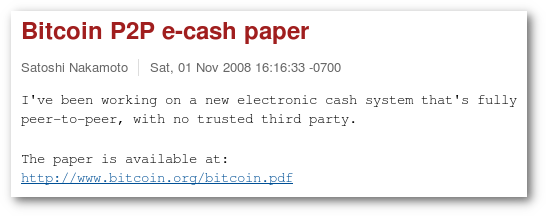Die Geburt des Bitcoin (BTC)
Satoshi Nakamotos erstes Posting zum Bitcoin

An einem Sonntag, dem 01.11.2008 um 16:16 Uhr, wird der Bitcoin quasi geboren. Der Erfinder des Bitcoin, der legendäre Satoshi Nakamoto, postet zu diesem Zeitpunkt unter dem Betreff "Bitcoin P2P e-cash paper".
Wer wissen will, wann und wie der Bitcoin (BTC) das Licht der Welt erblickte findet hier die erste öffentliche Bekanntmachung vom Erfinder Satoshi Nakamoto.
Was ist ein Whitepaper?
Die etwas merkwürdige Bezeichnung "Whitepaper" (Weißbuch, stammt ursprünglich aus dem politischen Bereich) ist ein kurzer Bericht oder Leitfaden, der die Essenz eines komplexen Themas prägnant aufbereitet, um den Lesern einen schnellen Zugang zu ermöglichen.
Das Bitcoin-Whitepaper
Das Bitcoin-Whitepaper erklärt kurz und prägnant, welche Idee hinter dem Bitcoin steckt und wie er funktioniert. Es begann mit einem Posting in der Cryptography Mailing List, nachzulesen beispielsweise hier.

Satoshi Nakamoto Sat, 01 Nov 2008 16:16:33 -0700 - Das Posting, das die Welt veränderte!
Hier ein kurzer Auszug aus dem vollständigen Whitepaper, das über den Link im Original aufgerufen werden kann:
I've been working on a new electronic cash system that's fully peer-to-peer, with no trusted third party.The paper is available at: https://www.bitcoin.org/bitcoin.pdfThe main properties:
- Double-spending is prevented with a peer-to-peer network.
- No mint or other trusted parties.
- Participants can be anonymous.
- New coins are made from Hashcash style proof-of-work.
- The proof-of-work for new coin generation also powers the network to prevent double-spending.
Bitcoin: A Peer-to-Peer Electronic Cash SystemAbstract. A purely peer-to-peer version of electronic cash would allow online payments to be sent directly from one party to another without the burdens of going through a financial institution. Digital signatures provide part of the solution, but the main benefits are lost if a trusted party is still required to prevent double-spending. We propose a solution to the double-spending problem using a peer-to-peer network. The network timestamps transactions by hashing them into an ongoing chain of hash-based proof-of-work, forming a record that cannot be changed without redoing the proof-of-work. The longest chain not only serves as proof of the sequence of events witnessed, but proof that it came from the largest pool of CPU power. As long as honest nodes control the most CPU power on the network, they can generate the longest chain and outpace any attackers. The network itself requires minimal structure. Messages are broadcasted on a best effort basis, and nodes can leave and rejoin the network at will, accepting the longest proof-of-work chain as proof of what happened while they were gone.
Toll, Danke Satoshi! :)

